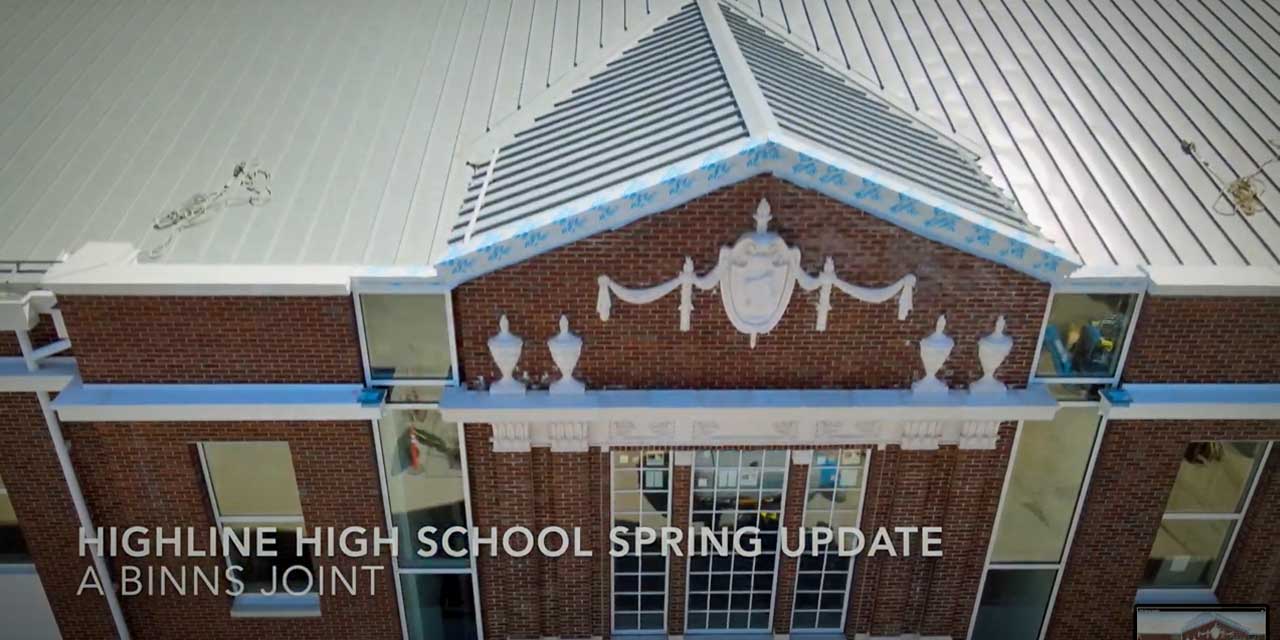During the COVID pandemic, Highline High School social studies teacher Jeb Binns didn’t just binge watch reruns of “Room 222,” he became a pilot – of a drone – and he’s been filming flyover updates of construction of the new school campus for the last year or so.
Binns flies a DJI Mavic Mini 2, known for its lightness and size, as well as for not requiring an FAA license. However, despite weighing below the 249 gram threshold, Binns occasionally still needs to get permission to fly – an “unlock code” – from the Federal Aviation Administration due to the school’s proximity to Sea-Tac Airport.
Here’s Binns’ latest flyover showing progress at the new Highline High campus (note that the new buildings look so pristine they resemble artist renderings!):
And here’s a Q&A we conducted with him:
Q: Does flying a drone require an FAA license? Do you have to get permission to fly over the new HHS campus?
A:To fly in the SeaTac area you have to get an FAA unlock code, assume responsibility for your actions, and follow the ceiling 119 meters that’s established. Additionally, there is a “geo-fence” that stops your drone from flying too close to SeaTac. It was actually difficult to get photos of the new tennis courts because I kept “running into the fence”!
Q: How long have you been droning?
A: My drone was my pandemic present to myself. And then I decided to share some of the images and joy with my colleagues and community. We needed, and still need, something to look forward to as we all slogged through the COVID days. Before I bought this drone, I played with the helicopter versions, but their technology is so far inferior to this product.
Q: Do you use a headset, smartphone or other FPV-type controller?
A: The Mavic Air 2 has a proprietary controller that integrates with your smart phone. The Mavic Air 2 comes with several different cables to plug into your phone. I’m using my iPhone XS and I see what’s seen by the camera. To make it all work, you attach and connect your phone, load the DJI Fly app, and connect with your aircraft and off you go!
Q: Do you plot out a course first, then just send the drone off? Or is it all manual flying?
A: I fly manually for the most part. There are several preset modes that you can do and use for certain shots. The slow pull away shot is called a “dronie” (a selfie with a drone)…and there are boomerang and helix shots that use the camera technology to focus on a particular spot and then flies a set pattern.
Q: Please give some details on what you’ve filmed flying over/around the new HHS campus.
A: For the most part I’ve tried to keep some consistent shots so people can see the change over time. I usually start with a closeup of the front of the school, do a north/south flyover, and a south to north flight from the Mosier Field parking lot. My hope is to focus on the common areas in my next video because the new outdoor seating/learning areas look amazing, and I can’t wait to be allowed to set foot on campus.
Q: What do you think of the new school/campus?
A: I think the new school looks amazing! This is the learning space that our students and community have deserved for many years. We are so grateful and thankful that the voters in the district supported this project. We, as staff, are looking forward to campus tours. According to Principal Salee, we will be finding out our new classrooms next week, and today we learned information about the big move in.
Q: Have you crashed it yet?
A: Luckily, I have not crashed the drone yet, knock on wood! I have trimmed a few leaves off a tree though! I did some flying at Bogus Basin in Idaho over winter break. I sent the drone out so far, that I freaked out that I might not remember how to get it home. The drone has an amazing range, they claim 10K, but with cellular interference I don’t really want to push and find out what the true range really is. According to DJI, if it loses signal it will return to you…but without an unlimited budget, I think I’ll keep it closer to home. There was a time that a flock of geese came flying at my drone, and I was worried for all parties concerned…but no honkers nor drones were injured in the filming of that video!
Q: What’s the process for getting an “unlock code” from the FAA?
A: I believe that licensure has a few components – one is size, and I think the other is commercial interest. If you sell your footage I think you need a license but if you publish for free or don’t sell it you’re good to go. As for the zone unlock, you go to the DJI website and select the drone and the region you’d like to fly in. Then you have to see what the rules and regulation are. If you fly in Gregory Heights, for example, you have to get a Sea-Tac unlock code, but if you fly at Alki you don’t. It’s all about proximity to flight paths and sensitive areas (prisons, stadiums military bases, etc.)
Q: What do you use to edit the videos?
A: I am using iMovie to do the editing, I’m self-taught, which is evident from some of my videos, but I hope I’m getting better. I was excited that several of my HHS films have over 1,000 views.
Q: Any tips for new drone pilots?
A: Fly a bunch…practice flying using line of sight, so you get the feel of the controls without having to “see” what the drone sees and then you develop the feel for the controls and controller. Get good at flying through the eye of the drone, that way when you pop down on the other side of a building you don’t panic and can navigate without hitting anything. The thing I’m most scared of is power wires. They are hard to see, hard to judge height and distance, are small enough that the auto crash detection sensors won’t see them, and I’m sure will pack a wallop if you smack into them!
OTHER ‘BINNS JOINT’ HIGHLINE HIGH FLYOVERS:


